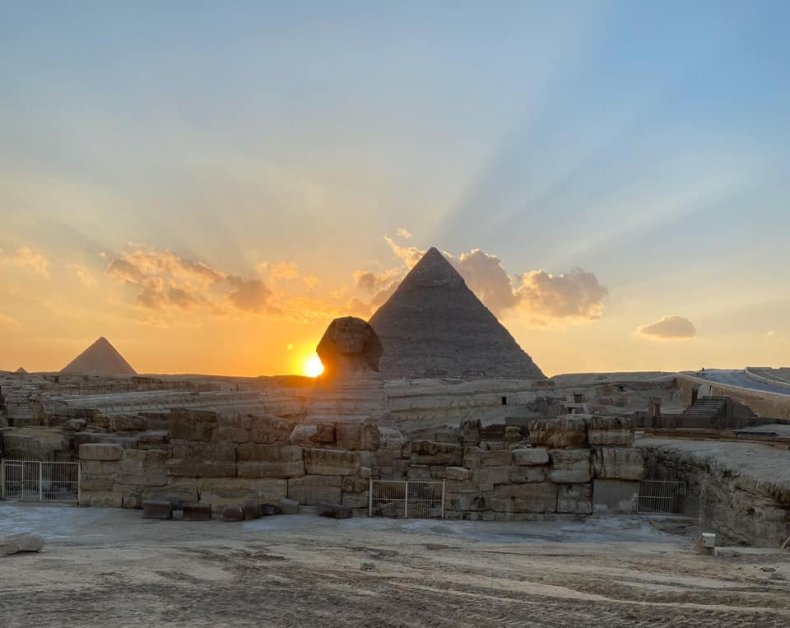https://www.newsweek.com/pyramid-ancient-egypt-equinox-1493770
Sun Sets over Ancient Egyptian Sphinx and Giza Pyramids on Spring Equinox
An image showing the sun setting over the right shoulder of the Sphinx statue on spring equinox has been released by Egypt's Ministry of Antiquities. The image shows the carving with the Giza pyramids of Khafra directly behind, and Khufu—also known as the Great Pyramid of Giza—to the left.
Zahi Hawass, the former Minister of Antiquities, said the image shows that there is an astronomical and religious element to the carving. This is contrary to what some archaeologists believe—that the positioning of the sphinx was accidental, with no link to astronomical events.
Hawass said the alignment between the sun and the sphinx happens twice a year during the spring and autumn equinoxes. Both events mark the point at which day and night are equal in length.The sun setting between the pyramid of Khufu and Khafra suggests an astronomical link, Hawass says. The Ancient Egyptians worshiped the sun, with the God of Ra being one of the most important in the civilization's religion. The Sphinx of Giza, which was built around 4,500 years ago, is believed to have been built for, and to represent, the pharaoh Khafre, who was the son of Khufu.

The link between astronomy and the construction of the pyramids has been the subject of research for decades. The Great Pyramid of Giza is known to be almost perfectly aligned to the points of north, south, east and west. A number of ideas have been put forward for this feat, including the use of constellations and the sun.
In 2018, a study published in the Journal of Ancient Egyptian Architecture suggested that the secret of this near perfect alignment relates to the fall equinox.
Glen Dash, an engineer who studied Egypt's pyramids, looked at the alignment of the Great Pyramid of Khufu, the Pyramid of Khafre and the Red Pyramid and found all three were well aligned. He also found all three had the same small error, being rotated ever so slightly counterclockwise from the cardinal points. He suggests the ancient Egyptians used a straight rod and the shadow it cast to track the movement of the sun on the equinox. On the equinox, the top of the shadow would run in a straight line from east to west, Dash said.
"The Egyptians, unfortunately, left us few clues," he concluded. "No engineering documents or architectural plans have been found that give technical explanations demonstrating how the ancient Egyptians aligned any of their temples or pyramids. No Egyptian compasses have ever been discovered, nor has any other type of sophisticated survey equipment."
Dash said that using the method they describe, the results produced match the alignments of these three pyramids. "It is hard to imagine a method that could be simpler either conceptually or in practice," he said.
-- Sent from my Linux system.
No comments:
Post a Comment